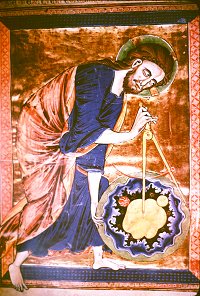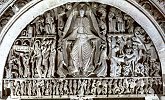Medieval: Romanesque Period |
Medieval: Romanesque Period |

Although very little significant architecture was built between 500-1000, church building increased dramatically from the 11th century on. These churches were built in Europe during a confident and aggressive period -- after the Arabs had been defeated in most of western Europe and as the first Crusades were being launched. The increase in church building is also connected with the growth of cities, the popularity of pilgrimages, and a new mobility among the populace. Many of these churches are quite large, demanding many man-hours and much expense -- though they will become even larger during the Gothic period.
Originating in France, the architectural style called "Romanesque" eventually spread throughout most of western Europe. For example, when the Normans conquered Britain, as depicted in the Bayeux Tapestry, they took the Romanesque style there, where it became known as "Norman" architecture. Although the style varies in different localities, Romanesque architecture generally has these qualities:
 Because some churches were constructed over many decades, the architectural styles in a particular church may vary as new ideas were incorporated into the plan.
Because some churches were constructed over many decades, the architectural styles in a particular church may vary as new ideas were incorporated into the plan.
By the 11th century architects had achieved a high status. One manuscript depicts God as an architect creating the earth with a compass, an architect's tool. Architects were regarded as practicing a liberal art, not merely a useful skill. Learning both mathematics and geometry, they developed this skill over a long apprenticeship. Good architects were probably mobile, moving from one town to the next. Although the names of a few architects survive, they are not usually credited with particular churches since these churches were a community effort built over a long period of time.
 |
Pilgrimage churches | |
 |
Bayeux Tapestry | |
 |
"Norman" architechture | |
 |
Architectural sculpture | |
 |
Pisa Cathedral | A quick review question! |
All images marked MAS were photographed on location by Mary Ann Sullivan. All other images were scanned from other sources or downloaded from the World Wide Web; they are posted on this password-protected site for educational purposes, at Bluffton College only, under the "fair use" clause of U.S. copyright law.